 The new Corvette LT1 engine, the first of the Gen 5 family of Small Block engines, combines several advanced technologies, including direct injection, Active Fuel Management and continuously variable valve timing to support an advanced combustion system.
The new Corvette LT1 engine, the first of the Gen 5 family of Small Block engines, combines several advanced technologies, including direct injection, Active Fuel Management and continuously variable valve timing to support an advanced combustion system.
“Our objective for the development of the all-new LT1 was to raise the bar for performance car engines,” said Mary Barra, senior vice president, global product development.
“We feel that we have achieved that by delivering a true technological masterpiece that seamlessly integrates a suite of advanced technologies that can only be found on a handful of engines in the world.
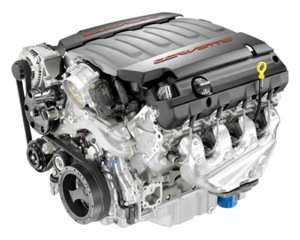 “What makes this engine truly special is the advanced combustion system that extracts the full potential of these technologies. The art and science behind that combustion system make the Corvette LT1 one of the most advanced V8 engines in the world,” said Barra.
“What makes this engine truly special is the advanced combustion system that extracts the full potential of these technologies. The art and science behind that combustion system make the Corvette LT1 one of the most advanced V8 engines in the world,” said Barra.
Output, performance, and fuel economy numbers will be finalized early this year, but the new LT1 engine is expected to deliver:
• The most powerful standard Corvette ever, with preliminary output of 450 horsepower and 450 lb.-ft. of torque;
• The quickest standard Corvette ever, with estimated 0-60 performance of less than four seconds;
• The most fuel-efficient Corvette ever, exceeding the 2013 EPA-estimated 26 miles per gallon on the highway.
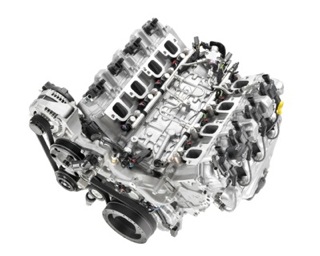 • “The Holy Grail for developing a performance car is delivering greater performance and more power with greater fuel economy and that’s what we’ve achieved,” said Tadge Juechter, Corvette chief engineer. “By leveraging technology, we are able to get more out of every drop of gasoline and because of that we expect the new Corvette will be the most fuel-efficient 450 horsepower car on the market.”
• “The Holy Grail for developing a performance car is delivering greater performance and more power with greater fuel economy and that’s what we’ve achieved,” said Tadge Juechter, Corvette chief engineer. “By leveraging technology, we are able to get more out of every drop of gasoline and because of that we expect the new Corvette will be the most fuel-efficient 450 horsepower car on the market.”
Advanced Combustion System Optimized with 6 Million Hours of Analysis
“The Corvette LT1 represents the most significant redesign in the Small Block’s nearly 60-year history – building on its legacy to make one of the world’s best engines even better,” said Sam Winegarden, vice president, Global Powertrain Engineering.
“More than just great horsepower, the LT1 has been optimized to produce a broader power band. Below 4,000 rpm, the torque of the Corvette LT1 is comparable to that of the legendary, 7.0L LS7 out of the current Corvette Z06.
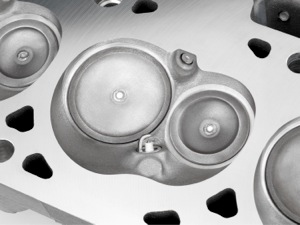 The LT1 is a sweetheart of a power plant and drivers will feel its tremendous torque and power at every notch on the tachometer.”
The LT1 is a sweetheart of a power plant and drivers will feel its tremendous torque and power at every notch on the tachometer.”
Increased power and efficiency were made possible by an unprecedented level of analysis, including computational fluid dynamics, to optimize the combustion system, the direct injection fuel system, active fuel management and variable valve timing systems that support it.
More than 10 million hours of computational analysis were conducted on the engine program, including 6 million hours (CPU time) dedicated to the advanced combustion system.
Direct injection is all-new to the engine architecture and is a primary contributor to its greater combustion efficiency by ensuring a more complete burn of the fuel in the air-fuel mixture.
This is achieved by precisely controlling the mixture motion and fuel injection spray pattern. Direct injection also keeps the combustion chamber cooler, which allows for a higher compression ratio.
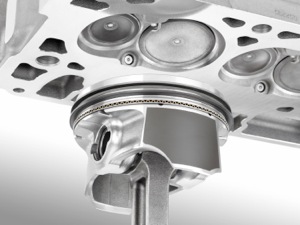 Emissions are also reduced, particularly cold-start hydrocarbon emissions, which are cut by about 25%.
Emissions are also reduced, particularly cold-start hydrocarbon emissions, which are cut by about 25%.
Active Fuel Management (AFM) – a first-ever application on Corvette – helps save fuel by imperceptibly shutting down half of the engine’s cylinders in light-load driving.
Continuously variable valve timing, which GM pioneered for overhead-valve engines, is refined to support the LT1 AFM and direct injection systems to further optimize performance, efficiency and emissions.
These technologies support the all-new, advanced combustion system, which incorporates a new cylinder-head design and a new, sculpted piston design that is an integral contributor to the high-compression, mixture motion parameters enabled by direct injection.
The LT1 head features smaller combustion chambers designed to complement the volume of the unique topography of the pistons’ heads. The smaller chamber size and sculpted pistons produce an 11.5:1 compression ratio, while the head features large, straight and rectangular intake ports with a slight twist to enhance mixture motion.
This is complemented by a reversal of the intake and exhaust valve positions, as compared to the previous engine design. Also, the spark plug angle and depth have been revised to protrude farther into the chamber, placing the electrode closer to the center of the combustion to support optimal combustion.
The pistons feature unique sculpted topography that was optimized via extensive analysis to precisely direct the fuel spray for a more complete combustion. The contours of the piston heads are machined to ensure dimensional accuracy – essential for precise control of mixture motion and the compression ratio. 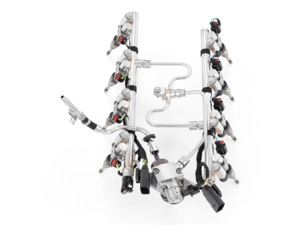
Race-Proven, State-Of-The-Art Performance
The first Small Block V-8 debuted in the Corvette in 1955. It displaced 4.3L (265 cubic inches) and was rated at 195 horsepower, drawing air and fuel through a four-barrel carburetor. Five years later, V8 power helped Corvette secure its first victory at the 24 Hours of Le Mans.
In 2012, the Small Block-powered Corvette Racing C6.R beat Ferrari, BMW and Porsche to sweep the drivers’, team, and manufacturer championships in production-based American Le Mans Series GT class. These championships make Corvette Racing the most successful team in ALMS history, with a total of 77 class wins, eight drivers’ championships, and nine manufacturer and team championships since 2001.
“The engine requirements for a production car and a race car are remarkably similar,” said Jordan Lee, Small Block chief engineer and program manager. “In both cases, you want an engine that is powerful and efficient, compact and lightweight, and durable. That combination is what made the original Small Block so successful. Today, the introduction of state-of-the-art technologies and engineering makes one of the best performance car engines in the world even better.”
The new LT1 is the third engine in the Corvette’s history to be so-named, with previous versions introduced in 1970 (Gen 1) and 1992 (Gen 2). All iterations of the LT1 – and all Small Block engines – have shared a compact design philosophy that fosters greater packaging flexibility in sleek vehicles such as the Corvette.
 “The power and efficiency of the Small Block V8 are hallmarks of Corvette performance,” said Lee. “But, the compact size and great power-to-weight are just as important for the overall driving experience. The all-new LT1 will play a huge role in making the all-new Corvette a world-class sports car, in terms of technology, performance, and refinement.”
“The power and efficiency of the Small Block V8 are hallmarks of Corvette performance,” said Lee. “But, the compact size and great power-to-weight are just as important for the overall driving experience. The all-new LT1 will play a huge role in making the all-new Corvette a world-class sports car, in terms of technology, performance, and refinement.”
Features and Highlights
All-aluminum block and oil pan: The Gen 5 block was developed with math-based tools and data acquired in GM’s racing programs, providing a light, rigid foundation for an impressively smooth engine. Its deep-skirt design helps maximize strength and minimize vibration. As with the Gen 3 and Gen 4 Small Blocks, the bulkheads accommodate six-bolt, cross-bolted main-bearing caps that limit crank flex and stiffen the engine’s structure. A structural aluminum oil pan further stiffens the powertrain.
The block features nodular iron main bearing caps, which represent a significant upgrade over more conventional powdered metal bearing caps. They are stronger and can better absorb vibrations and other harmonics to help produce smoother, quieter performance.
Compared to the Gen 4 engine, the Gen 5’s cylinder block casting is all-new, but based on the same basic architecture. It was refined and modified to accommodate the mounting of the engine-driven direct injection high-pressure fuel pump. It also incorporates new engine mount attachments, new knock sensor locations, improved sealing and oil-spray piston cooling.
Advanced oiling system, with available dry-sump system: The LT1 oiling system – including oil-spray piston cooling – was also optimized for improved performance. It is driven by a new, variable-displacement oil pump that enables more efficient oil delivery, per the engine’s operating conditions. Its dual-pressure control enables operation at a very efficient oil pressure at lower rpm coordinated with AFM and delivers higher pressure at higher engine speeds to provide a more robust lube system for aggressive engine operation.
Standard oil-spray piston cooling sprays the underside of each piston and the surrounding cylinder wall with an extra layer of cooling oil, via small jets located at the bottom of the cylinders. For optimal efficiency, the oil jets are used only when they are needed the most: at start-up, giving the cylinders extra lubrication that reduces noise, and at higher engine speeds, when the engine load demands, for extra cooling and greater durability.
An available dry-sump oiling system promotes exceptional lubrication system performance during aggressive driving maneuvers and high cornering loads. It includes two stages: a pressure stage and a scavenge stage. The pressure stage includes the new, dual-pressure-control and variable-displacement vane pump.
Dexos semi-synthetic motor oil, with a 5W30 specification, helps reduce friction to further enhance the LT1’s efficiency.
New, tri-lobe camshaft: Compared to the Gen 4 Small Block, the camshaft remains in the same position relative to the crankshaft and is used with a new rear cam bearing, but it features an all-new “tri-lobe” designed lobe which exclusively drives the engine-mounted direct injection high-pressure fuel pump, which powers the direct-injection combustion system. The cam’s specifications include 14mm/13.3mm (0.551/0.524-inch) intake/exhaust lift, 200/207-crank angle degrees intake/exhaust duration at 0.050-inch tappet lift and a 116.5-degree cam angle lobe separation.
New, cam-driven fuel pump: The direct injection system features a very-high-pressure fuel pump, which delivers up to 15Mpa (150 bar). The high-pressure, engine-driven fuel pump is fed by a conventional fuel-tank-mounted pump. The direct injection pump is mounted in the “valley” between cylinder heads – beneath the intake manifold – and is driven by the camshaft at the rear of the engine. This location ensures any noise generated by the pump is muffled by the intake manifold and other insulation in the valley.
PCV-integrated rocker covers: One of the most distinctive features of the new engine is its domed rocker covers, which house the, patent-pending, integrated positive crankcase ventilation (PCV) system that enhances oil economy and oil life, while reducing oil consumption and contributing to low emissions.
The rocker covers also hold the direct-mount ignition coils for the coil-near-plug ignition system. Between the individual coil packs, the domed sections of the covers contain baffles that separate oil and air from the crankcase gases – about three times the oil/air separation capability of previous engines.
 Intake manifold and throttle body assembly: The LT1’s intake manifold features a “runners in a box” design, wherein individual runners inside the manifold feed a plenum box that allows for excellent, high-efficiency airflow packaged beneath the car’s low hood line.
Intake manifold and throttle body assembly: The LT1’s intake manifold features a “runners in a box” design, wherein individual runners inside the manifold feed a plenum box that allows for excellent, high-efficiency airflow packaged beneath the car’s low hood line.
Acoustic foam is sandwiched between the outside top of the intake manifold and an additional acoustic shell to reduce radiated engine noise, as well as fuel pump noise.
The manifold is paired with an electronically controlled throttle, featuring an 87mm bore diameter and a “contactless” throttle position sensor design that is more durable and enables greater control.
Four-into-one exhaust manifolds: The LT-1 uses a cast version of the “four-into-one” short-header exhaust manifold design used on the Gen 4 LS7 engine. The cast header passages enable consistent exhaust flow into the “wide mouth” collector at the converter.
Cooling system, humidity sensor and more: Additional features and technologies of the Gen 5 Small Block include:
• A revised cooling system with an offset water pump and thermostat for more efficient performance;
• Air induction humidity sensor ensures optimal combustion efficiency, regardless of the surrounding air’s humidity;
• 58X ignition system with individual ignition coil modules and iridium-tip spark plugs;
• All-new “E92” engine controller.












